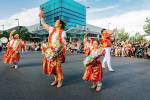Civil rights proponent funded Berkley Square neighborhood
Berkley Square represents more than a historic neighborhood. As the recently unveiled plaques and banners say, the first subdivision built in Nevada for and by blacks is a “dream come true.”
The neighborhood was named for Thomas Berkley, who financed the project. Berkley was a 2nd lieutenant in the U.S. Army during World War II, a lawyer practicing in Oakland, Calif., and a publisher and co-owner of the weekly publications the Oakland Post and El Mundo.
He was a staunch civil rights supporter concerned about housing opportunities for the black community, according to Berkley’s 2001 Los Angeles Times obituary.
Construction of the neighborhood — just north of Owens Avenue, between D and H streets — and its 148 homes ended in 1955.
Jarmilla McMillan was one of the neighborhood’s first residents. She was the daughter of a Las Vegas dentist, James McMillan, former president of the local NAACP.
“This has always been a warm community with big streets and sidewalks,” Jarmilla McMillan, now a member of the city’s historical preservation committee, said. “The people were warm. To this day, I’m still friends with my old neighbors.”
Architect Paul Revere Williams designed the neighborhood. Williams was the architect behind Las Vegas projects such as the La Concha Motel, the Guardian Angel Cathedral and the Royal Nevada hotel. He also designed the homes of entertainers Frank Sinatra, Lucille Ball and Zsa Zsa Gabor.
Williams also carries the distinction of being the first black architect initiated into the American Institute of Architects.
Las Vegas historical preservation officer Courtney Mooney said Berkley Square stands as a symbol .
“The neighborhood was important for the civil rights movement,” she said. “For many of the people moving in, it was the first time they had indoor plumbing or sidewalks.”
The subdivision was conceived as a Federal Housing Administration project, for which, until then, minorities were ineligible, according to the office of historic preservation.
The neighborhood is a prime example of Federal Housing Administration projects — one-story contemporary-style ranch houses, curved streets to slow traffic and sidewalks separated from the pavement by planting strip — that, in addition to its cultural significance, landed Berkley Square on the National Register of Historic Places in October 2009, Mooney said.
The city of Las Vegas recognized the milestone by commissioning plaques and banners that told the history of the neighborhood. The artwork was unveiled during a ceremony in February.
Artist Joseph Watson thanked the community for allowing him to participate in the project.
“I wanted to create works of art for the neighborhood that mean something to them,” he said during the ceremony. “I hope everyone enjoys the work as much as I enjoyed creating it.”
Funding for the 10 banners came from a $20,000 grant from the Commission for the Las Vegas Centennial.
For McMillan, the recognition is important.
“I’ve always held Berkley Square deep in my heart,” she said during the ceremony. “I’m happy to see the city has taken the time to recognize this black community.”
Contact Paradise/Downtown View reporter Nolan Lister at nlister@viewnews.com or 702-383-0492.




























